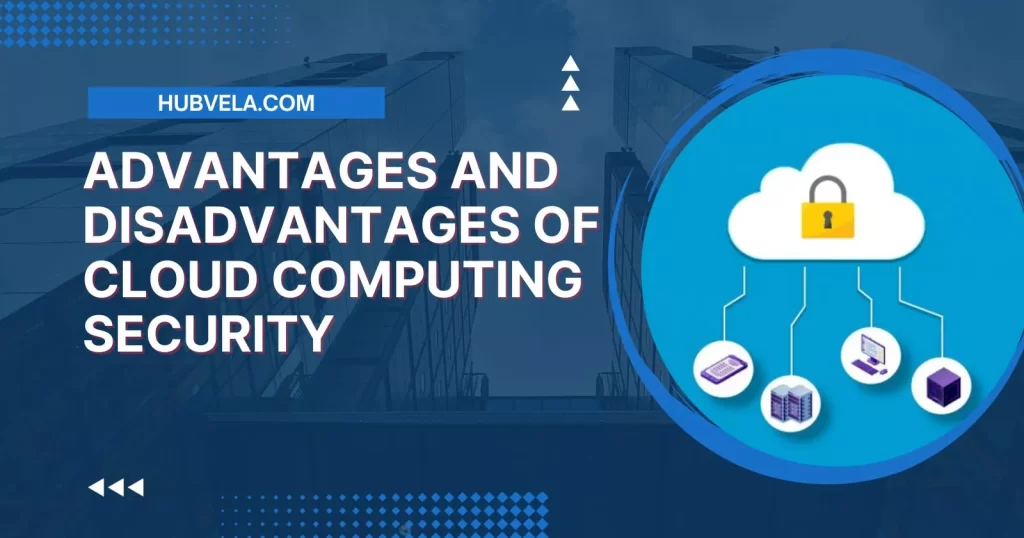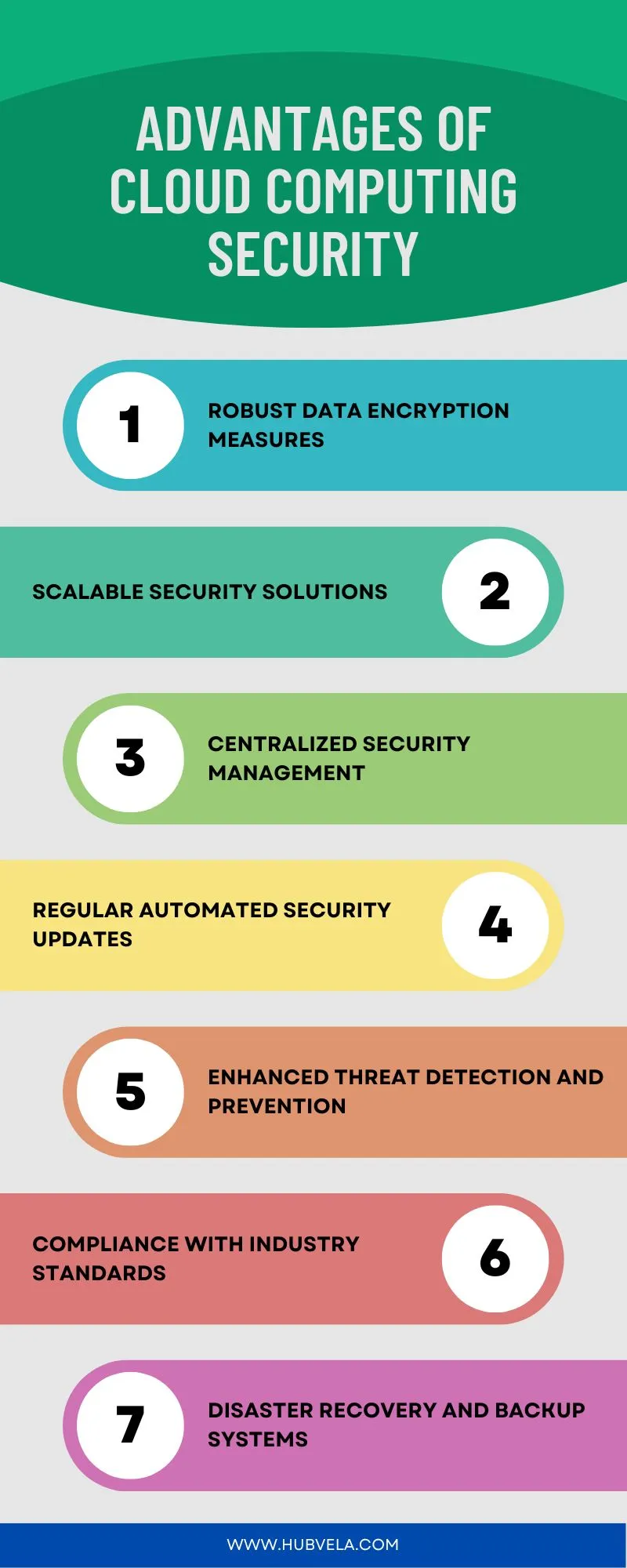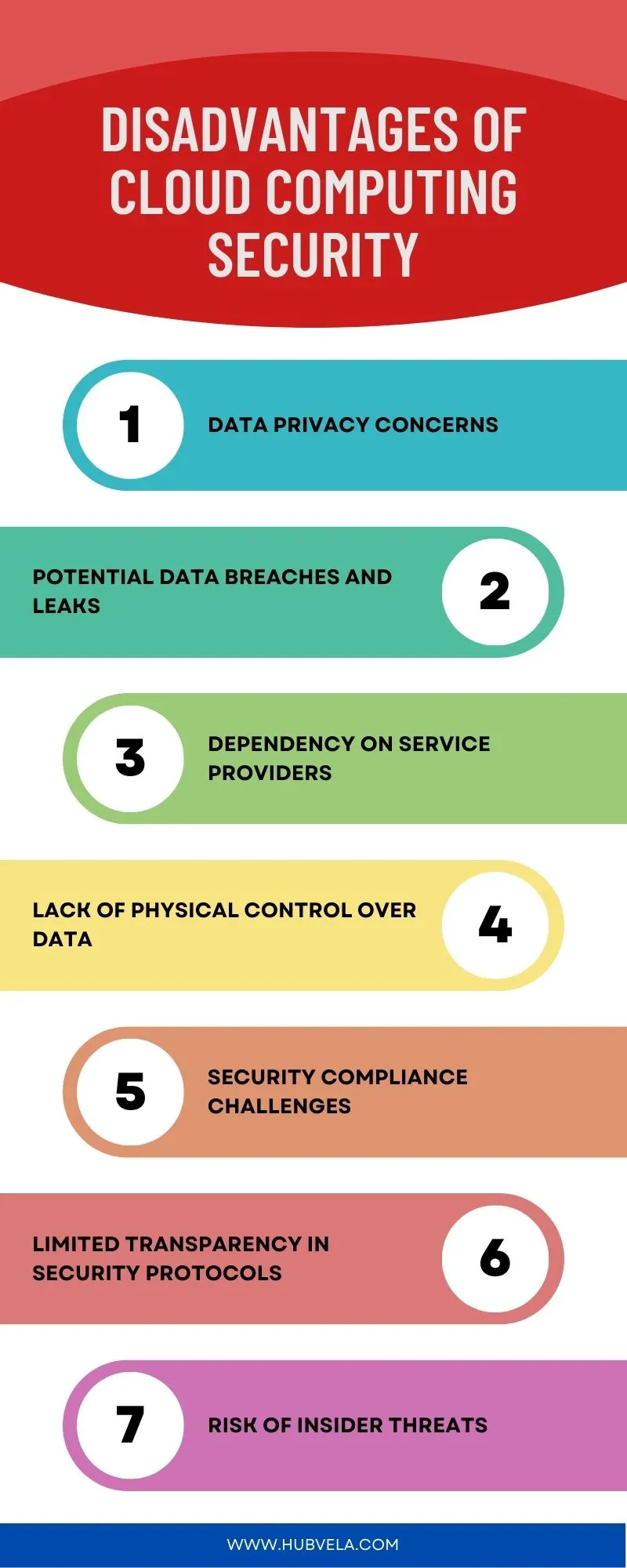Cloud computing security or cloud security, is an evolving sub-domain of computer security, network security, and data security.
It encompasses a broad set of policies, technologies, and controls deployed to safeguard data, applications, and related infrastructure in cloud computing.
Cloud security offers various advantages such as efficient recovery, cost-effectiveness, scalability, and 24×7 visibility, but it also presents challenges like limited control and visibility, security concerns, and potential data breaches.
In this article, we will explore the advantages and disadvantages of cloud computing security, shedding light on its benefits and potential risks.

--Advertisement--
Advantages of Cloud Computing Security
Cloud computing security offers numerous advantages for organizations looking to protect their data and assets in the digital landscape.
As more businesses leverage cloud-based technologies for agility, flexibility, and scalability, the importance of cloud security becomes increasingly evident.
We will delve into various advantages of cloud computing security and its significance in safeguarding sensitive information in the digital era.

1. Robust Data Encryption Measures
Robust data encryption measures are an essential aspect of cloud computing security. Encrypting sensitive data is a fundamental practice for safeguarding information in the cloud.
It is crucial to ensure that data is encrypted both in transit and at rest. Implementing strong encryption algorithms and securely managing encryption keys helps protect sensitive information from unauthorized access.
Even if an unauthorized entity gains access to your data, it will be rendered useless without the decryption key. Employing strong encryption algorithms ensures that even if data is compromised, it remains unusable to unauthorized individuals.
2. Scalable Security Solutions
Scalable security solutions are a key advantage of cloud computing security, offering organizations the flexibility to adapt to changing security needs as their business grows.
Cloud security solutions provide scalability and flexibility by leveraging the power and resources of cloud computing infrastructure, allowing users to easily scale across new buildings and locations without the need to manage infrastructure such as increasing electricity usage, maintenance, and upgrades.
This scalability enables businesses to increase the number of licenses as they grow, rather than performing an entire server update, thus providing unlimited scalability.
Additionally, cloud security solutions ensure high availability and continuity by incorporating real-time support, 24/7 monitoring, and built-in redundancies, which keep websites and applications online and functional even in the event of an attack.
This flexibility and scalability of cloud security solutions contribute to their effectiveness in meeting the evolving security needs of modern organizations.
3. Centralized Security Management
Centralized security management is a key advantage of cloud computing security. Traditional on-premises enterprise security environments are usually decentralized, which means IT teams must manage and maintain security at every single location and for every single application.
In contrast, a centralized security approach can manage all enterprise endpoints from external threats, protecting the entire corporate network from external threats.
IT teams can manage security functions like spam filtering, firewall controls, virus and spyware protection, two-factor authentication, and Virtual Private Networking (VPN) at a company-wide scale.
Centralized cloud security also eliminates the need to invest in on-premises hardware and maintenance, resulting in both cost and time savings.
4. Regular Automated Security Updates
Cloud security solutions provide automated and continuous updates to protect against evolving security threats, ensuring that the systems are always equipped with the latest security patches and defenses.
This proactive approach to security maintenance reduces the burden on organizations to manually manage updates and patches, thereby enhancing the overall security posture.
Regular automated security updates also contribute to the agility and scalability advantages of cloud computing security, allowing organizations to adapt to new security challenges efficiently and effectively.
This approach helps in maintaining a robust security posture, reducing the risk of security breaches, and ensuring the confidentiality, integrity, and availability of data and applications in the cloud environment.
5. Enhanced Threat Detection and Prevention
One of the advantages of cloud computing security is enhanced threat detection and prevention. Cloud security solutions provide the most effective protection against Distributed Denial of Service (DDoS) attacks, which are increasing in numbers, magnitude, sophistication, and severity.
Cloud computing security helps to continuously monitor, identify, analyze, and mitigate DDoS attacks. The built-in redundancies, customizability, flexibility, scalability, and intelligence of such solutions can prevent volumetric, low, and slow attacks.
Additionally, cloud security solutions deploy a range of advanced security tools to protect customer applications and data, such as fine-grain identity and access controls, continuous monitoring, threat detection, network and application protection, multiple encryption layers, automated incident response and recovery, and more.
Cloud security also provides greater visibility into the inner workings of the cloud, namely what data assets are present and where they live, who is using the cloud services, and the kind of data they are accessing.
6. Compliance with Industry Standards
Compliance with industry standards is a crucial aspect of cloud computing security, offering several advantages to organizations.
Cloud security solutions provide continuous monitoring, advanced threat detection, and data security by design, ensuring compliance with industry standards such as GDPR, HIPAA, and PCI DSS.
These solutions enable 24×7 visibility into the risk posture, higher availability, and pay-as-you-go models, aligning with industry standards for data protection and privacy.
Furthermore, cloud data security reduces the total cost of ownership and administrative burden, while also offering greater visibility and easy backups and recovery, which are essential for compliance with industry regulations.
By leveraging cloud security, organizations can benefit from the inherent security measures and advanced tools provided by cloud providers, ensuring adherence to industry standards and regulations.
7. Disaster Recovery and Backup Systems
Disaster recovery and backup systems are crucial components of cloud computing security. Cloud-based disaster recovery solutions offer several benefits, including cost-effectiveness, scalability, and automation.
With cloud-based disaster recovery, businesses can back up their entire server in one go, making it easy to recover data in the event of a disaster.
Cloud-based solutions also allow for frequent and non-disruptive testing of IT disaster recovery efforts, which strengthens the disaster recovery plan.
Additionally, cloud providers implement robust security measures, including encryption, access controls, and regular security audits, to ensure that data remains secure while in transit and at rest.
By utilizing cloud-based disaster recovery, businesses can minimize physical infrastructure dependency, reduce costs, and eliminate the need for extensive system downtime.
Cloud-based disaster recovery strategies are becoming more mature, and the benefits they offer are increasing.
Disadvantages of Cloud Computing Security
Cloud computing has become an integral part of modern businesses, providing numerous benefits such as scalability, flexibility, and cost savings.
However, with the adoption of cloud computing comes the need to ensure that the organization’s cloud security strategy is capable of protecting against the top threats to cloud security.
The disadvantages of cloud computing security are a growing concern for businesses of all sizes. We will explore the top disadvantages of cloud computing security.

1. Data Privacy Concerns
One of the major disadvantages of cloud computing security is data privacy concerns. Cloud infrastructure is designed to be easily usable and to enable easy data sharing, making it difficult for organizations to ensure that data is only accessible to authorized parties.
Misconfigurations of cloud security settings are a leading cause of cloud data breaches, and many organizations’ cloud security posture management strategies are inadequate for protecting their cloud-based infrastructure.
Additionally, placing sensitive data on the cloud has created major security concerns for many organizations, as they lack the knowledge to ensure that they and their employees are using it securely.
This lack of control over sensitive data can lead to data loss, data leakage, and user account hijacking. Therefore, organizations must perform regular risk assessments, adopt new strategies and skills specific to cloud computing, and ensure that they understand the implications of the shared responsibility model.
2. Potential Data Breaches and Leaks
Cloud computing offers numerous advantages, but it also presents potential data breaches and leak risks. One of the primary concerns is the exposure of sensitive data due to misconfigurations, unauthorized access, insecure interfaces/APIs, and hijacking of accounts.
Organizations may lack the knowledge to ensure secure usage of cloud computing, putting sensitive data at risk of exposure.
Additionally, the dependence on cloud service providers for security highlights the importance of choosing a quality provider to mitigate the risk of data breaches.
Furthermore, the lack of visibility and ownership of infrastructure in the cloud, along with the challenges in performing incident response effectively, can lead to data breaches and leaks.
These security challenges underscore the need for organizations to have a robust cloud security strategy and the necessary skills to mitigate the risks effectively.
The potential for data breaches and leaks in cloud computing necessitates a comprehensive approach to security to safeguard sensitive information and maintain the integrity of organizational data.
3. Dependency on Service Providers
One of the significant disadvantages of cloud computing security is the dependency on service providers for security measures.
Organizations that adopt cloud computing often rely on cloud service providers (CSPs) for the security of their data and infrastructure.
This reliance can lead to a lack of complete visibility and control over the security measures implemented, as organizations depend on the security arrangements of the CSPs.
As a result, organizations may face challenges in ensuring the effectiveness of incident response and maintaining a robust cloud security strategy.
Additionally, the shared responsibility model, which outlines the security duties of the cloud provider and the user, can lead to misunderstandings and potential security vulnerabilities if not properly understood and managed.
Therefore, while cloud computing offers numerous advantages, the dependency on service providers for security introduces significant concerns and risks that organizations need to address to ensure the protection of their sensitive data and infrastructure.
4. Lack of Physical Control Over Data
One of the significant disadvantages of cloud computing security is the lack of physical control over data. When organizations store their data in the cloud, they relinquish direct control over the physical infrastructure where the data is stored.
This lack of control can lead to concerns about data security, privacy, and compliance. According to CrowdStrike, “Cloud may give organizations agility, but it can also open up vulnerabilities for organizations that lack the internal knowledge and skills to understand security challenges in the cloud effectively”.
Additionally, placing this data on the cloud has its advantages but also has created major security concerns for 66% of organizations.
This issue is further compounded by the fact that traditional security tools and processes may be ineffective in a cloud-based infrastructure, as mentioned by Check Point Software Technologies.
Therefore, organizations need to carefully consider the trade-offs between the benefits of cloud computing and the potential security risks associated with the lack of physical control over their data.
5. Security Compliance Challenges
Security compliance in cloud computing presents several challenges for organizations. One major challenge is ensuring regulatory compliance when moving data to the cloud. Organizations must adhere to various regulations such as PCI DSS and HIPAA to protect sensitive data like credit card information and healthcare records.
Achieving and demonstrating regulatory compliance in the cloud can be more difficult due to the complexities of cloud infrastructure and the need for specialized cloud compliance solutions.
Additionally, misconfigurations of cloud security settings can lead to non-compliance, posing a significant risk of legal exposure and potential compromise of a company’s reputation.
The shared responsibility model, which outlines the security duties of the cloud provider and the user, further complicates compliance efforts, as organizations must understand and address their specific responsibilities within this model.
Ensuring security compliance in cloud computing requires organizations to navigate a complex landscape of regulations, shared responsibilities, and potential vulnerabilities, making it a critical and challenging aspect of cloud security.
6. Limited Transparency in Security Protocols
One of the disadvantages of cloud computing security is the limited transparency in security protocols. Cloud computing introduces the challenge of limited visibility into network operations, misconfigurations, data loss, and accidental data exposure.
This lack of transparency and control over data and systems in the cloud can leave businesses vulnerable to various vulnerabilities and misconfigurations, impacting their security posture.
Additionally, the shared responsibility for addressing and mitigating these risks between the cloud provider and the customer further complicates the matter, making it critical for organizations to obtain visibility into their cloud services to ensure security, privacy, and adherence to best practices.
Therefore, businesses must ensure that their cloud service provider offers complete transparency regarding the security measures implemented by their system administrators to mitigate these risks effectively.
7. Risk of Insider Threats
The risk of insider threats is a significant disadvantage of cloud computing security. Insider threats refer to cybersecurity threats that come from within the organization, usually by a current or former employee or other individuals with direct access to the company network, sensitive data, and intellectual property.
According to Gartner, through 2025, 99% of all cloud security failures will be due to some level of human error, making human error a constant risk when building business applications.
Hosting resources on the public cloud magnifies the risk of insider threats, as individuals with access to internal documents or emails could use them to damage a company’s reputation and sabotage its stock price.
Breaches continue to be an imposing threat to companies using the cloud, and detecting a malicious insider in cloud deployments is even more difficult due to the lack of control over the underlying infrastructure and the difficulty in detecting such threats.
Organizations that lack the knowledge to ensure secure usage of cloud computing are at risk of exposing sensitive data, making insider threats a major concern in cloud security.
Conclusion on Advantages and Disadvantages of Cloud Computing Security
In conclusion, cloud computing security has both advantages and disadvantages. The advantages include lower costs, scalability, efficient recovery, and higher availability, among others.
On the other hand, the disadvantages include limited control and visibility, security concerns, and reliance on internet access. Despite the risks, many organizations are migrating to the cloud due to its cost-effectiveness, flexibility, and scalability.
To mitigate the disadvantages, organizations can implement proper configuration of security settings, regular data backup, and user education, among other measures.


